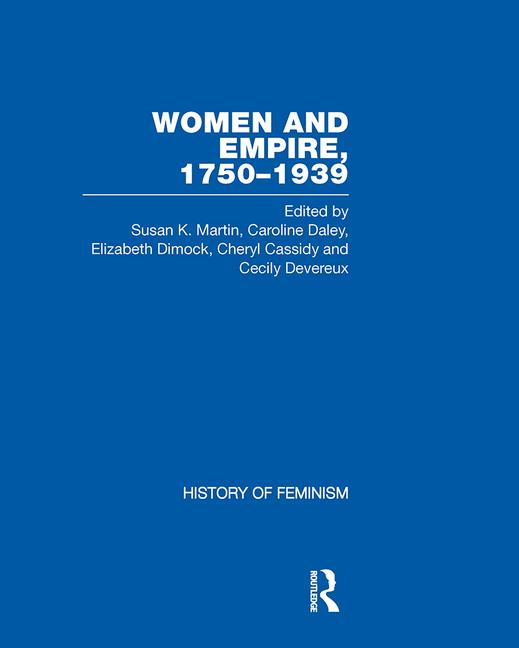Access to the full content is only available to members of institutions that have purchased access. If you belong to such an institution, please log in or find out more about how to order.
Loading content
We were unable to load the content

Women and Empire, 1750-1939 Primary Sources on Gender and Anglo-Imperialism
- Published: 26 Jan 2009
- DOI: 10.4324/9780415310925
- Set ISBN: 9780415310925
Women and Empire, 1750–1939: Primary Sources on Gender and Anglo-Imperialism functions to extend significantly the range of the History of Feminism series (co-published by Routledge and Edition Synapse), bringing together the histories of British and American women’s emancipation, represented in earlier sets, into juxtaposition with histories produced by different kinds of imperial and colonial governments. The alignment of writings from a range of Anglo-imperial contexts reveals the overlapping histories and problems, while foregrounding cultural specificities and contextual inflections of imperialism. The volumes focus on countries, regions, or continents formerly colonized (in part) by Britain:
Perhaps the most novel aspect of this collection is its capacity to highlight the common aspects of the functions of empire in their impact on women and their production of gender, and conversely, to demonstrate the actual specificity of particular regional manifestations. Concerning questions of power, gender, class and race, this new Routledge–Edition Synapse Major Work will be of particular interest to scholars and students of imperialism, colonization, women’s history, and women’s writing.
Set Contents
Australia was a European idea and colonial prospect before it became a colony. Like most colonial holdings it was in many ways produced by the imperial centre, while also contributing to the decentring of Britain (Hall 2005: 10). In particular, Australia was figured as a rich source for natural wonders, facilitating new empirical studies and classification of the people and places ‘discovered’ (Smith 1989; Miller 1996). At the same time it was a screen for the projection of fantasies of appropriation and ownership. Gendered notions of colonizing a welcoming feminine land, informed by Romantic aesthetic traditions, did not fully take hold in Australia, being quickly displaced by a dominant narrative in which the hostility of the landscape must be countered by masculine vigour or stolid, sometimes feminized, endurance. The timing of Australian settlement at the end of the eighteenth century meant that the tools and understandings brought to Australia’s ‘preindustrial’ landscape were industrial ones (Lines 1992: xvi) and ideas of noble savagery and sublime vistas were quite rapidly replaced by more utilitarian and evangelical approaches to the country and its people. Both were European frameworks, imposed on the existing understandings of place, time, and subjectivity carried by the indigenous people, and though the noble savage ideal was less overtly hostile to the Aboriginal people, dispossession was the end result (S. Ryan 1996: 101–27; Coleman 2005).
In 1912 a leading London newspaper declared that ‘[i]n the making of Empire woman plays but little direct and visible part’. Eveline Mitford thought this an ‘astonishing assertion’, but conceded that it was ‘probably the opinion of most people who have not gone into the question for themselves, for the great duties and responsibilities that rest upon women in the arduous work of moulding a new country are rarely recognised or appreciated’.1 It was the heyday of ‘new imperialism’, that period between the mid-1870s and the outbreak of the First World War when there was an unprecedented outpouring of imperial sentiment and pursuit of imperial gains.2 The previous year a month-long Imperial Conference had been held in London and the Festival of Empire had been celebrated at the Crystal Palace. At the time Mitford was writing the League of Empire had just held the first conference of teachers’ associations from around the Empire and the Duke of Westminster was busy establishing a new ‘Imperial Fund’ to further imperial causes.3 Yet women’s work within and for the Empire was still being ignored. As Mitford noted, the British press was happy to report men’s imperial achievements, but ‘the work of women in our Dominions is rarely considered of sufficient interest to be chronicle[d]’.4
In 1912, Sarojini Naidu, Indian poetess, political activist, first governor of the state of Uttar Pradesh, as well as wife, mother, orator, and envoy, published a book of poems, The Bird of Time, which captured the rhythms and images of the India she cherished. Perhaps a metaphor for the long century of British rule, one of Naidu’s poems, ‘An Indian Love Song’, tells of a young woman refusing her lover’s addresses because, ‘The feud of old faiths and the blood of old battles sever thy people and mine’ (Naidu 1912). Feuds and battles certainly characterized events in India beginning in the first third of the nineteenth century and continuing until India’s independence in the 1940s. And many of the clashes in India throughout the nineteenth century and into the twentieth did indeed ‘sever’ Naidu’s people from the British and Americans who travelled, occupied, evangelized, and succoured on the subcontinent. Yet, in significant ways, the events that created conflicts between Westerners and the peoples of India inevitably connected both groups, especially when seen through women’s eyes.